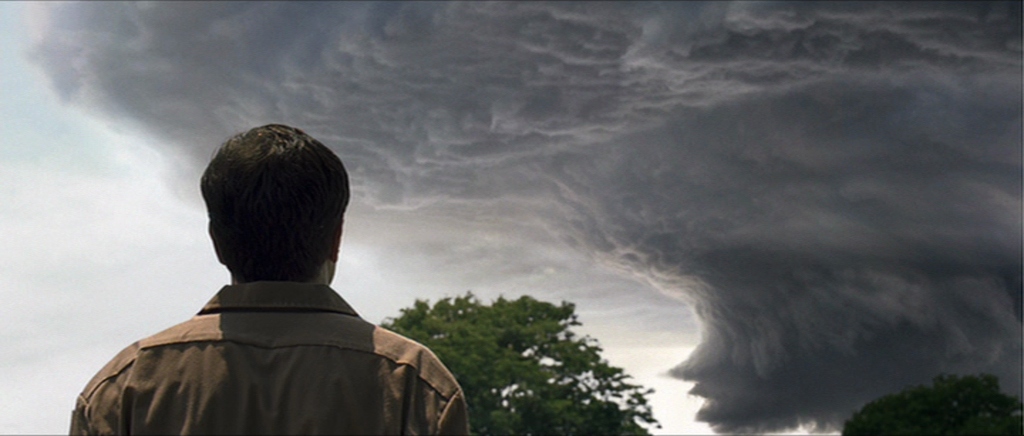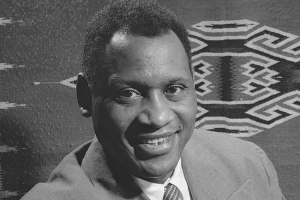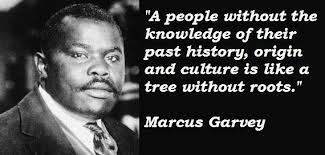“We’s Who’s the Earth is For”: Storm Visions
Ciarán O’Rourke reviews Take Shelter and Beasts of the Southern Wild
A decade ago I began to form a habit that in the intervening years has evolved into a strange passion: going to the cinema, and watching movies, alone! Two films in particular, from those early days, seemed so urgent and exhilarating, so attuned to what was then (and is still) being talked about as the greatest threat to civilization, climate change, but at a human level, that I lay a good deal of the responsibility for my cinematical hermeticism at their feet.
I saw Take Shelter and Beasts of the Southern Wild in short succession, and they both taught me something about how to see, and read, and think about environmental devastation as a collective experience, from the confines of my own small life. Each picture still filters my understanding of the many dooms that are already taking shape about us, and are promised to intensify in the time ahead.

Take Shelter (2011) begins with an apocalypse that only Curtis (Michael Shannon) can see, which nevertheless threatens to envelop everything he knows. Staring at trees shaking and shimmering in the wind, Curtis watches, as in the backdrop an immense storm cloud gathers, and oleaginous rain begins to splatter his shirt and hair. The film proceeds as a close-focused portrait of a loner in crisis, as Curtis risks his job, family, financial stability, and standing in his community to build an underground bunker for his loved ones, in anticipation of an ecological and social disaster that nobody else understands, or wants to.
Jeff Nichols’s film offers (as the title suggests) an admonitory projection of an atomised America drowning in a storm of oil, a storm that only one incorrigibly reticent man, whose sanity is questioned throughout, can discern. Take Shelter was released three years before the Flint water crisis laid bare the reality of the USA’s poisoned waters, along with the social regimes ensuring that some people would suffer the effects of failed public infrastructure more than others. Likewise in 2005, six years prior to Nichols’s picture, the people of New Orleans had been left to fend for themselves by the federal government in the wake of Hurricane Katrina, and were then criminalised for surviving. Nichols’s cinematic parable is alert to the reality of these murder-traps, and still perturbs, mixing fantastical foreboding with the sharp, persistent tang of realism.
The downtrodden longing of dispossessed communities
Watching the movie now, it’s difficult to imagine any other actor than Shannon for the part of Curtis. Shannon, in his late thirties in the film, has the truculent, creviced features and uneasy, watchful gaze of an ageing veteran from a forgotten war. He conveys both seething anxiety and blank-eyed stolidity, and seems always to have wandered onto the screen from some Great Nowhere, that lost hinterland where America’s ghosts have been left to die. Curtis wakes from nightmares screaming, or asphyxiated in terrified paralysis. When lightning crashes in a far-off field, he flinches, and lurches instinctively to draw his young daughter (who is deaf) into the house. The lines between sight and vision, climactic crisis and personal breakdown, grow blurry, as Curtis mutters in disbelief and trepidation: “Is anyone seeing this?”

In some respects, Shannon is comparable to Henry Fonda in The Grapes of Wrath, the “only actor” of the 1930s with whom the writer James Baldwin “identified” as a youth, just “by the way [he] walked down the road at the end of the film”. For Baldwin, Fonda’s onscreen presence was such that his whiteness was almost erased, composed not of savage entitlement but of empathic anger and downtrodden longing: he epitomised in his person those dispossessions endured by predominantly black and brown communities in the actual nation that Baldwin knew while growing up. The foreboding that we see encoded into Shannon’s permanently pained expressions is partly the face of white America turned back upon itself; he is a witness to catastrophe that none of his neighbours recognise, and against which there is no protection.
Nichols’s picture is set in America’s backlands, near Elyria, Ohio, where Walmart remains one of the city's top five employers, and (in the movie) Curtis and his friend Dewart (Shea Whigam) work in a gravel pit. Left deflated and unappeased by liberal policy-makers in Washington, within half a decade of the film’s making, places like this would embrace the demagogic populism of Donald Trump, as he began his march to the White House. The dread Curtis feels in nightmares, as friends and neighbours are driven to acts of visceral violence and desperation, accurately foreshadows the rancour and resentment stoked by Trump in reality.
In the micro-drama of Curtis’s escalating distress, which may be madness, we also glimpse the macro-epic of climate catastrophe, baring its fangs. “It rained for two hours yesterday”, his boss snaps in exasperation, “Two hours, and our entire [drilling] schedule went into the toilet.” Industrial productivity, not to mention human survival, becomes considerably more difficult and dangerous when the natural systems it depends on move with a gargantuan rhythm and momentum of their own. Take Shelter registers the pulse of a maelstrom that later films like Parasite dramatise in full-blown action.
Bird-murmurations swarm the skies, then vanish at a glance. When Curtis expresses his disquiet during a medical appointment, his doctor swivels his chair away from him, asking, “You been out to see your mother”, living in psychiatric care, “lately?” For Curtis, to question the seeming complacency of his peers is to be consigned to outsider status, exiled. When he does visit his mother (Kathy Baker), he wonders quietly if she can remember what happened before she was “diagnosed”. “It was a real stressful time”, she says in a soft voice, “Your father was gone a lot... there was always a panic that took hold of me.”
Nichols’s visual grammar is often so beguiling because of his parallel capacity to enter the inner (and intimate) life of his characters. Much of the power of Take Shelter, indeed, lies in its recognition that many of its central characters can’t: the precarity and many burdens of their days are such that the very idea of safety, sustainable comfort, enduring happiness is constantly endangered. “You got a good life”, says Dewart to his friend and workmate. “Well, it ain't always so easy”, Curtis replies, looking away.
This is a drama in which basic medical procedures and prescriptions are frequently out of financial reach; where people are expected to pay (somehow), or suffer. Curtis’s wife, Samantha (Jessica Chastain), sells hand-sewn curtains and quilts at the local car-boot sale for extra cash. When Curtis gets “a home-improvement loan” from the bank to build the tornado shelter in his back garden, he jeopardizes his ability to cover the expense of Hannah’s hearing implants. “How could you do that without talking to me”, Samantha almost pleads: “Tell me something that helps me understand why you're being like this.” He breathes heavily: “There's nothing to explain.”
Private calamity and collective crisis
Communication and understanding, their necessity and frustration, are organising motifs in this strangely symphonic drama of private calamity and collective crisis. We watch transfixed as Chastain’s Samantha, whose searching intelligence makes even silence eloquent, teaches Hannah “a new sign” word, and the windows of the house grow grey: “S-T-O-R-M”. When Curtis eventually tells his wife about the “dreams, I guess they're more like nightmares”, he evokes the “dark, thick rain, like fresh motor-oil.” Such terse, weighted lines could be taken from a play by Sam Shepard (an actor-writer who adds to the grounded gravitas of Nichols’s 2012 feature, Mud). “It’s not just a dream”, Curtis says, “It’s a feeling. I’m afraid something might be coming. Something that’s not right. I cannot describe it. I just need you to believe me.” The times are out of joint.
The question of belief, of human faith-in-one-another, is resolved only ambiguously in this movie, which brings us face to face with a premonition of extinction that is at once powerful and difficult to absorb in full. Curtis’s slow diffidence and physical unease nevertheless convey what we (and he) cannot quite define in verbal terms.

The picture is in some respects comparable to Field of Dreams (1989), in which despite accusations from all sides of insanity, financial and medical, the character Ray (Kevin Costner) knows that “if he builds” a baseball field on his land, “people will come”:
They’ll arrive at your door, as innocent as children, longing for the past… Then they’ll walk off to the bleachers, sit in their shirtsleeves on a perfect afternoon… and they’ll watch the [baseball] game, and it will be as if they dipped themselves in magic waters.
Curtis’s nightmares repeat the same parable, but in altered form. If he builds his storm shelter, the apocalypse he’s felt brewing for so long will strike: his worst fears will be vindicated..
In a vivid distillation of Curtis’s anguish and isolation, after fighting with Dewart in the mess hall, frothing at the mouth he yells: “There is a storm coming. Like nothing you've ever seen. And not one of you is prepared for it.” None of his friends and neighbours can look him in the eye. “Sleep well in your beds”, he screams, “because if this comes true there ain’t gonna be any more.” Then, turning to Samantha and Hannah, his eyes clearing as he meets their faces, he crumples into tears, in agony and shame.
“To believe your own thought, to believe that what is true for you in your private heart is true for all men – that is genius”, Emerson once wrote, urging that each “man” should “carry himself in the presence of all opposition, as if everything were titular and ephemeral but he”. Curtis’s actions exemplify the stubborn wildness of such a credo, while exposing the preposterous insulation of its originator. Curtis’s need to trust his convictions “in the presence of all opposition”, his will to act on the recurring, fearful visions he sees, cost him nearly all he has. Emerson’s sermon at the pulpit exacted no such toll on the eminent philosopher.

In similarly immersive fashion, Beasts of the Southern Wild (2012) dramatises the experience, at an almost bodily level, of fragility in the midst of social and climactic collapse. Set on a small Louisiana island, in a forgotten town called The Bathtub, the film is narrated and led by Hushpuppy (Quvenzhané Wallis), who lives in a decrepit portakabin, suspended by trees, with her father Wink (Dwight Henry). Their home is alive with rust, and roots; lit by weather and lived in by birds and (sometimes the strangest of) beasts.
The first words we hear in the film, in voiceover, are faltering, precise, and powerfully expressive of the world Hushpuppy knows and the binding laws she intuits to be true there: “All the time, everywhere, everything's hearts are beatin’ and squirtin’, and talkin’ to each other the ways I can't understand.” Hushpuppy's statement of incomprehension is deep and real with wisdom, partly because (like Curtis) she understands more, perhaps, than she can allow herself to say out loud.
We see Hushpuppy holding a chick in her small hands firmly, and yet with total gentleness. Patrolling a nearby junkyard in her faded yellow wellington boots, she lays her arm across a recumbent hog, sleeping in the mud, and listens for its heartbeat, a gesture she repeats throughout the film, motivated by the nameless but palpable sickness that is increasingly depleting Wink of energy and aggravating his mood.
“I hope you die”, she shouts at Wink, after he has struck her in anger and panic. She punches his chest, and we see, on his face, a flicker of remorse and grief. He will die (soon), and he recognises that at some instinctive level Hushpuppy already knows it. When Wink collapses, in seizure, a rumble of thunder sounding in the skies, Hushpuppy quivers in open-eyed distress at this great apocalypse descending on her father, and overtaking their life together, which is grubby, precarious, and full.
The earth is for us
Hushpuppy and Wink fish in a scrap-metal boat that floats on the mud-brown river, which, as in one of Mark Twain’s quintessential (and insightful) yarns, is always “raising”. After floods, the water becomes choked, in large measure due to a forbidding levee, which separates Hushpuppy and her people from the smoke-spewing industrial landscape beyond, where the American State reigns. “Ain't that ugly over there”, Wink says, nodding in the direction of the factory towers: “We got the prettiest place on earth.” In moments like this, Benh Zeitlin’s film (his first) has truth and grit in equal measure, which may account for its overall vitality, its magnificent flavour.
“They built the wall that cut us off”, Hushpuppy proclaims, with a kind of triumph: “They think we all gonna drown down here, but we ain't goin nowhere... The Bathtub has more holidays than the rest of the world!” In the form of The Bathtub, the commons has survived, and we see its openness and revelry, the plenteous river, and the fellowship that thrives in and around it, up-close. This is a place where people share their resources, knowledge, and company, together in nature.
“Everything is part of the buffet of the universe”, smiles the kindly Miss Bathsheba (Gina Montana), who tells the local huddle of listening children before her of the fierce, ravenous aurochs, now extinct, which once roamed the earth. As Wink’s illness takes hold of his body, violent storms rocking and wracking their home, Hushpuppy is haunted by these creatures, looming and immense: they shadow her world. “I'm recording my story for the scientists of the future”, she says, without irony, fear or self-pity.
This is also, however, a community attuned to its own destruction. “Ice-caps gonna melt, water's gonna rise”, Miss Bethsheba says, so “y’all better learn to survive now”, an instruction Hushpuppy internalises, and converts to poetry, saying in a boat-speak vernacular:
One day, the storm's gonna blow, the ground's gonna sink, and the water's gonna rise up so high, there ain't gonna be no Bathtub, just a whole bunch of water.... But me and my Daddy, we stay right here. We’s who’s the earth is for.
The radicalism of Hushpuppy’s worldview is all the more startling for her resounding trust in it. Her intent, soft, observing eyes, her mellow, thoughtful words, find truth wherever they rest. “We’s who’s the earth is for.”
Take Shelter conjures the terror of a grown man who is both lost and anchored in a world over-shadowed by mortal catastrophes; Beasts of the Southern Wild re-creates the lush and often urgent textures of childhood, a time of true magic and deep yearning, in this case imperilled by those hungry predators, natural death, social and environmental devastation, and a coercive State. When Wink commits an act of sabotage on the dam in an attempt to clear the area of the now-stagnant waters, police and rescue teams arrive to implement an “emergency evacuation”, forcibly transferring the Bathtub community into homeless services. “It didn't look like a prison”, Hushpuppy remarks of the crowded medical centre where Wink is transferred, “It looked like a fish-bowl with no water.” If it is stirringly humane and fluently constructed, the film remains in touch (in A.S. Hamrah’s words) with “an America that is divorced from social services and beset by environmental collapse.”
The movie holds in balance an unflinching recognition of precarious lives faced down by (sometimes lethal) inevitabilities, and a child’s experience of community and fellowship – with nature and her people. Everything Hushpuppy loves comes close to vanishing, or actually dies, as the monsters that stalk her life knock down the walls, covering her world with swampy water.
Without shirking its responsibility to these sureties and circumstances, the final act dares to imagine some of the ways in which lost children may find warmth and protection nonetheless: in the arms of outcasts, or in the companionship of one another. Hushpuppy can walk back to the “raising” river and call it home. As we look into a future defined by certain loss and potential planetary ruin, the tenderness and fierce courage of this film quickens the heart.
Further Reading
James Baldwin, The Devil Finds Work (1976).
A. S. Hamrah, The Earth Dies Streaming: Film Writing 2002-2018 (2019).
Ralph Waldo Emerson, “Self-Reliance” (1841).



